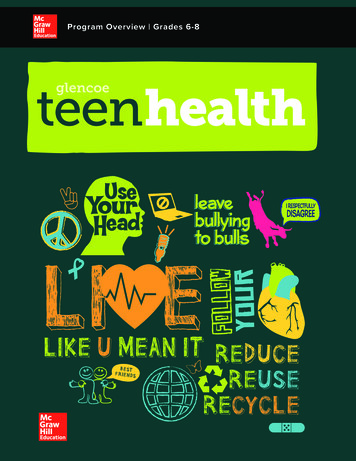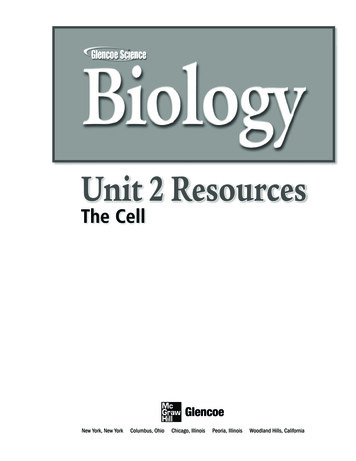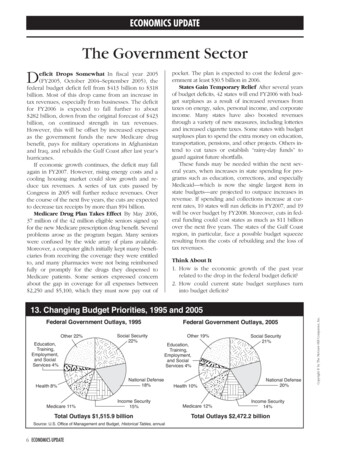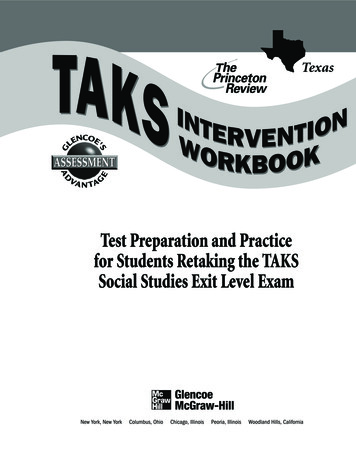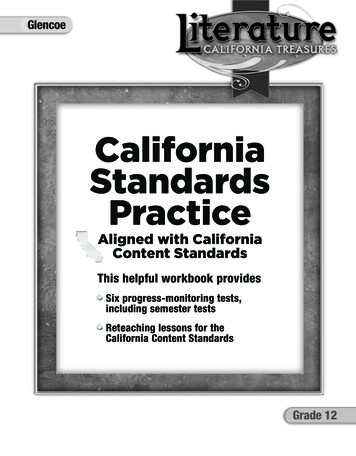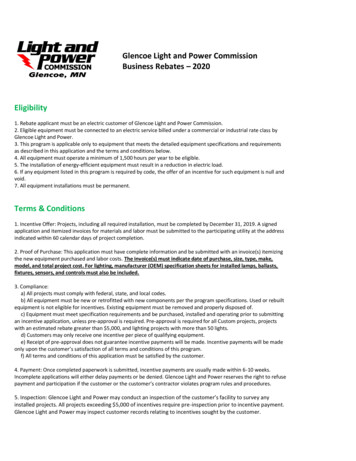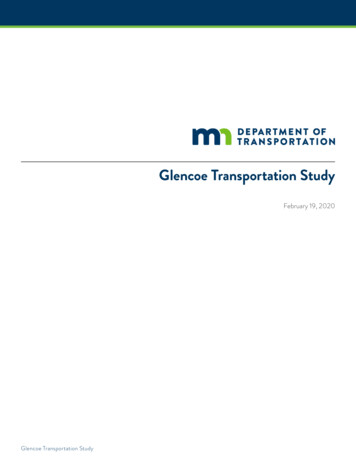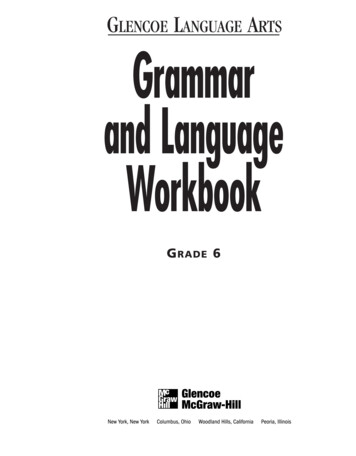
Transcription
Grades 6-12 Glencoe Literature Aligned with Common Core State Standards08/11LT 10 W 7911Grades 6-12Aligned with Common Core State StandardsFor English Language Arts and Literacy
McGraw-Hill School Education Group and Common Core StateStandards for English Language Arts and LiteracyMcGraw-Hill Education, with its long history of providing the highest quality language arts and literacymaterials for educators, supports the common core standards initiative. McGraw-Hill Education has the expertsand expertise in instruction and assessment to help implement the common core standards in a credible way. McGraw-Hill Education is an endorsing partner of the NGA/CCSSO common core initiative. McGraw-Hill Education supports the goal of producing a common core of voluntary state standards that arealigned with college and career expectations and that are reflective of cross-disciplinary skills such as criticalthinking and problem solving. McGraw-Hill Education employs psychometricians, technologists, and curriculum and pedagogical experts.Together with our authors, they are deeply immersed in the latest research and developments concerningeducation reform. McGraw-Hill Education’s research-based literacy programs align with the March 10, 2010 draft of the commoncore standards. We fully expect to correlate well to the final version of the common core standards. McGraw-Hill Education’s significant investments in technology will enable a seamless augmentation anddelivery of content. McGraw-Hill Education’s formative testing capabilities will empower teachers to use data to guide studentlearning of common standards. Our summative assessment practice provides credible, independent measures ofachievement that will support a new era of accountability. Our test development capabilities — from contentcreation through research and validation, to technology-enhanced delivery and reporting — are available toprovide the valid and reliable measurement of student mastery of common core standards.
Common Core State Standards Table of ContentsGrade 6.page 2Grade 7.page 52Grade 8.page 86Grade 9.page 132Grade 10.page 172Grade 11, American Literature.page 200Grade 12, British Literature.page 258Grades 9–10, World Literature.page 2961
Common Core State Standards GRADE 6This chart lists the Grade 6 Common Core State Standards and shows which pages in Glencoe Literature teach or review each standard.Common Core State Standards Grade 6Page ReferencesReading: LiteratureKey Ideas and Details1. Cite textual evidence to support analysis of what thetext says explicitly as well as inferences drawn from thetext.CCSS Project Practice Book:The Dog of Pompeii, pp. 3–20Pecos Bill, pp. 21–34Eleven, pp. 35–50Whatif and Jimmy Jet and His TV Set, pp. 51–64The Phantom Tollbooth, pp. 65–78Glencoe Literature:This standard is met on many After You Read pages. For example:The King of Mazy May, SE pp. 66–67Romulus and Remus, SE pp. 476–477from Brighton Beach Memoirs, SE pp. 768–770CCSS Project Practice Book:The Dog of Pompeii, pp. 3–20Pecos Bill, pp. 21–34Eleven, pp. 35–50Whatif and Jimmy Jet and His TV Set, pp. 51–64The Phantom Tollbooth, pp. 65–782. Determine a theme or central idea of a text and how itis conveyed through particular details; provide a summaryof the text distinct from personal opinions or judgments.2Glencoe Literature:The Fly, SE p. 5The Scribe, SE p. 21The Dog of Pompeii, SE p. 41The King of Mazy May, SE pp. 66, 68All Stories Are Anansi’s, SE pp. 75–80Dragon, Dragon, TE p. 86; SE pp. 93, 94Street Magic, TE p. 111; SE p. 112Stray, TE p. 118Continued.
Common Core State Standards Grade 6Page ReferencesPecos Bill, SE p. 133The Courage That My Mother Had, SE pp. 135–136, 139My Father Is a Simple Man, SE pp. 135, 137–139To Young Readers, SE pp. 159–160The Sand Castle, SE pp. 179–188who knows if the moon’s, SE p. 196The End of the World, TE p. 222; SE pp. 225, 226How the Snake Got Poison, SE p. 231Four Haiku: Seasons, SE p. 238Comparing Literature: He Lion, Bruh Bear, and Bruh Rabbit and The Toad and the Donkey, SE p. 279Eleven, SE pp. 299, 303My Parents, SE p. 308Same Song and Maestro, SE p. 313The All-American Slurp, SE p. 329Mad, SE p. 333Life Doesn’t Frighten Me, SE p. 341; TE p. 341Genre Focus: Poetry, SE p. 344Geraldine Moore the Poet, SE pp. 354, 359Wings, TE p. 371; SE p. 372Daydreamers, TE p. 378; SE p. 380Whatif and Jimmy Jet and His TV Set, SE p. 392Flowers and Freckle Cream, SE p. 400Arachne, SE p. 412The Fun They Had, TE p. 419To Captain John Smith, SE p. 448Looking for America, SE p. 458Spiders from All I Really Need to Know I Learned in Kindergarten, SE pp. 494–500The Wolf and the House Dog and The Donkey and the Lapdog, TE p. 504Comparing Literature: The Flying Machine and All Summer in a Day, SE p. 564; TE p. 561A Lesson in Courtesy, TE p. 586from Elie Wiesel: Voice from the Holocaust, SE p. 602The Secret Schools, SE p. 606Primary Lessons, TE p. 614Satchel Paige, SE pp. 627–637Eleanor Roosevelt, SE pp. 643–657; TE p. 650The Bracelet, SE p. 760Best of Buddies, SE p. 774The Golden Touch, SE p. 8143
Common Core State Standards Grade 6Page ReferencesCCSS Project Practice Book:The Dog of Pompeii, pp. 3–20Pecos Bill, pp. 21–34Eleven, pp. 35–50The Phantom Tollbooth, pp. 65–783. Describe how a particular story’s or drama’s plotunfolds in a series of episodes as well as how thecharacters respond or change as the plot moves toward aresolution.4Glencoe Literature:The Fly, SE pp. 5, 7The Dog of Pompeii, SE pp. 33, 37, 41The King of Mazy May, SE pp. 53–68; TE pp. 56, 57, 58All Stories Are Anansi’s, SE pp. 75–80Dragon, Dragon, SE pp. 82–94Street Magic, TE p. 108Stray, SE pp. 114–119Pecos Bill, SE pp. 123–134Writing Workshop, TE p. 142How the Snake Got Poison, TE p. 228Ta-Na-E-Ka, SE pp. 249–261; TE pp. 252, 258Comparing Literature: He Lion, Bruh Bear, and Bruh Rabbit and The Toad and the Donkey, SE pp. 271–279;TE p. 278Eleven, SE pp. 302, 303; TE p. 302The All-American Slurp, TE p. 322, SE pp. 329, 330Geraldine Moore the Poet, SE pp. 347–355Wings, SE pp. 361–373; TE pp. 367, 368Flowers and Freckle Cream, SE pp. 395–400Arachne, SE pp. 406–413; TE pp. 409, 411Persephone, TE p. 545Genre Focus, TE p. 659Damon and Pythias, TE p. 741Comparing Literature: Zlateh the Goat and The Boy Who Lived with the Bears, TE p. 822
Common Core State Standards Grade 6Page ReferencesCraft and StructureCCSS Project Practice Book:Pecos Bill, pp. 21–34Eleven, pp. 35–50Whatif and Jimmy Jet and His TV Set, pp. 51–64The Phantom Tollbooth, pp. 65–784. Determine the meaning of words and phrases as theyare used in a text, including figurative and connotativemeanings; analyze the impact of a specific word choiceon meaning and tone.Glencoe Literature:The Scribe, TE p. 10, 14, 15, 16, 17, 19The Dog of Pompeii, TE p. 39The King of Mazy May, TE pp. 55, 57Dragon, Dragon, TE p. 85Street Magic, SE pp. 103–112; TE pp. 105, 107Pecos Bill, TE pp. 124, 128; SE p. 133To Young Readers, TE p. 159who knows if the moon’s, SE pp. 195–197The End of the World, TE p. 224Four Haiku: Seasons, SE pp. 237, 239Ta-Na-E-Ka, TE p. 257Comparing Literature: He Lion, Bruh Bear, and Bruh Rabbit and The Toad and the Donkey, TE p. 272My Parents, TE p. 307Same Song and Maestro, SE pp. 309–314The All-American Slurp, TE p. 323Mad, SE pp. 331–333Genre Focus: Poetry, TE p. 344Geraldine Moore the Poet, TE pp. 348, 349; SE p. 354What I can do—I will—and Fame is a bee, SE pp. 357–359; TE p. 357Wings, TE pp. 365, 369; SE p. 372Daydreamers, SE pp. 377–381; TE p. 379Flowers and Freckle Cream, SE pp. 395–400; TE p. 398Yes, It Was My Grandmother and Good Luck Gold, SE pp. 401–404Romulus and Remus, TE p. 473A Lesson in Courtesy TE, p. 585The Secret Schools, TE p. 605The Sidewalk Racer and Alone in the Nets, TE p. 621Satchel Paige, TE p. 626Ode to Mi Gato, SE pp. 660–663Comparing Literature: Going Blind and from Ray Charles, TE p. 7025
Common Core State Standards Grade 6Page ReferencesCCSS Project Practice Book:The Dog of Pompeii, pp. 3–20Pecos Bill, pp. 21–34Eleven, pp. 35–50Whatif and Jimmy Jet and His TV Set, pp. 51–645. Analyze how a particular sentence, chapter, scene,or stanza fits into the overall structure of a text andcontributes to the development of the theme, setting, orplot.6. Explain how an author develops the point of view ofthe narrator or speaker in a text.6Glencoe Literature:The Dog of Pompeii, SE pp. 29–42; TE pp. 34, 35The King of Mazy May, TE p. 62; SE p. 67Dragon, Dragon, TE p. 92Street Magic, SE pp. 103–112; TE pp. 110, 111Stray, SE pp. 114–119The Sand Castle, SE pp. 179–187who knows if the moon’s, SE p. 196The End of the World, TE p. 223; SE p. 226How the Snake Got Poison, SE p. 231Four Haiku: Seasons, SE p. 237Ta-Na-E-Ka, TE p. 250; SE pp. 252, 254, 255Eleven, SE pp. 300, 301My Parents, TE pp. 306, 307; SE p. 308The All-American Slurp, SE pp. 316–330; TE pp. 317, 328Mad, SE p. 333I Dream a World and Life Doesn’t Frighten Me, SE pp. 338–343Genre Focus: Poetry, SE p. 344What I can do—I will—and Fame is a bee, SE p. 359Wings, TE pp. 362, 363, 365, 369, 370Daydreamers, SE p. 381Whatif and Jimmy Jet and His TV Set, SE pp. 388–393; TE p. 392The Fun They Had, SE pp. 416–424The Shutout, SE pp. 512–520The Phantom Tollbooth, Act One, SE pp. 776–801CCSS Project Practice Book:The Dog of Pompeii, pp. 3–20Eleven, pp. 35–50Whatif and Jimmy Jet and His TV Set, pp. 51–64Continued.
Common Core State Standards Grade 6Page ReferencesGlencoe Literature:The Scribe, SE pp. 11–22The Dog of Pompeii, SE p. 42Stray, TE p. 117Pecos Bill, SE pp. 123–134; TE p. 131The Sand Castle, SE p. 187who knows if the moon’s, SE p. 197The End of the World, p. 225The All-American Slurp, TE p. 320; SE p. 330I Dream a World, SE p. 339Life Doesn’t Frighten Me, TE p. 341Genre Focus: Poetry, SE p. 344; TE p. 345Wings, TE pp. 362, 364, 366Whatif, SE p. 389Comparing Literature: The Fun They Had and Why Books Are Dangerous, SE pp. 415–425Looking for America, TE p. 456The Southpaw, SE pp. 487–492Satchel Paige, SE pp. 627–637Comparing Literature: Going Blind and from Ray Charles, SE pp. 692–703The Bracelet, TE p. 750Integration of Knowledge and Ideas7. Compare and contrast the experience of readinga story, drama, or poem to listening to or viewing anaudio, video, or live version of the text, includingcontrasting what they “see” and “hear” when reading thetext to what they perceive when they listen or watch.CCSS Project Practice Book:Eleven, pp. 35–50Whatif and Jimmy Jet and His TV Set, pp. 51–64The Phantom Tollbooth, pp. 65–78Glencoe Literature:Media Workshop, SE p. 247; TE p. 247The Phantom Tollbooth, Act One, TE p. 7838. (Not applicable to literature)7
Common Core State Standards Grade 6Page ReferencesCCSS Project Practice Book:The Dog of Pompeii, pp. 3–20Pecos Bill, pp. 21–349. Compare and contrast texts in different forms orgenres (e.g., stories and poems; historical novels andfantasy stories) in terms of their approaches to similarthemes and topics.Glencoe Literature:The Dog of Pompeii, TE p. 36The King of Mazy May, SE p. 66Street Magic, SE pp. 103–112Comparing Literature: The Courage That My Mother Had and My Father Is a Simple Man, SE pp. 135–139The Sand Castle, TE p. 182Comparing Literature: He Lion, Bruh Bear, and Bruh Rabbit and The Toad and the Donkey, TE p. 271; SE p. 279Comparing Literature: The Fun They Had and Why Books Are Dangerous, SE pp. 415–425Independent Reading, TE p. 434Comparing Literature: The Flying Machine and All Summer in a Day, SE pp. 549–565Comparing Literature: Going Blind and from Ray Charles, SE pp. 692–703Damon and Pythias, TE p. 740Executive Order No. 9066, SE p. 760Comparing Literature: Zlateh the Goat and The Boy Who Lived with the Bears, SE pp. 815–831Range of Reading and Level of Text Complexity10. By the end of the year, read and comprehendliterature, including stories, dramas, and poems, inthe grades 6–8 text complexity band proficiently, withscaffolding as needed at the high end of the range.CCSS Project Practice Book:The Dog of Pompeii, pp. 3–20Pecos Bill, pp. 21–34Eleven, pp. 35–50Whatif and Jimmy Jet and His TV Set, pp. 51–64The Phantom Tollbooth, pp. 65–78Glencoe Literature:This standard is met throughout the book. For example:The King of Mazy May, SE pp. 52–68I Dream a World and Life Doesn’t Frighten Me, SE pp. 338–343The Phantom Tollbooth, Act One, SE pp. 775–8018
Common Core State Standards Grade 6Page ReferencesReading: Informational TextKey Ideas and Details1. Cite textual evidence to support analysis of what thetext says explicitly as well as inferences drawn from thetext.CCSS Project Practice Book:Tracking Trash, pp. 81–94The Emperor’s Silent Army, pp. 95–110Eulogy on the Dog, pp. 111–126Eleanor Roosevelt and In Eleanor Roosevelt’s Time, pp. 127–140Comparing Literature: Going Blind and from Ray Charles, pp. 141–154Glencoe Literature:This standard is met on many After You Read pages. For example:Tracking Trash, SE pp. 168–169Eulogy on the Dog, SE pp. 482–483Eleanor Roosevelt, SE pp. 656–657CCSS Project Practice Book:Tracking Trash, pp. 81–94The Emperor’s Silent Army, pp. 95–110Eulogy on the Dog, pp. 111–126Eleanor Roosevelt and In Eleanor Roosevelt’s Time, pp. 127–140Comparing Literature: Going Blind and from Ray Charles, pp. 141–1542. Determine a central idea of a text and how it isconveyed through particular details; provide a summary ofthe text distinct from personal opinions or judgments.Glencoe Literature:Hurricane Heroes, SE p. 27What Exactly Is a Hero?, SE pp. 47–51from Yukon Gold: The Story of the Klondike Gold Rush, TE p. 70; SE p. 72Three Queens of Egypt, SE p. 100, TE p. 100Functional Documents, SE pp. 171–177Nobody’s Perfect, TE p. 191; SE p. 193The Emperor’s Silent Army: Terracotta Warriors of Ancient China, TE p. 206Climate, TE p. 214; SE p. 216from Dust Tracks on a Road, SE p. 235Ballpark Food, TE pp. 241, 246; SE p. 243–246Continued.9
Common Core State Standards Grade 6Page ReferencesMedia Workshop, SE p. 247Ta-Na-E-Ka, SE p. 260These Walls Can Talk, TE p. 267; SE p. 270Interview with Naomi Shihab Nye, TE p. 335; SE p. 336King Minos and Art on the Palace Walls, SE p. 376The Gene Scene, SE p. 387Why Books Are Dangerous, SE p. 424Dressed for Success, SE p. 463Functional Documents, SE pp. 464–468Gentleman of the Pool, SE p. 641Best of Buddies, SE p. 774CCSS Project Practice Book:Tracking Trash, pp. 81–94The Emperor’s Silent Army, pp. 95–110Eulogy on the Dog, pp. 111–126Eleanor Roosevelt and In Eleanor Roosevelt’s Time, pp. 127–140Comparing Literature: Going Blind and from Ray Charles, pp. 141–1543. Analyze in detail how a key individual, event, or ideais introduced, illustrated, and elaborated in a text (e.g.,through examples or anecdotes).Glencoe Literature:What Exactly Is a Hero?, SE pp. 47–51Three Queens of Egypt, SE pp. 96–101Nobody’s Perfect, SE pp. 190–193; TE p. 193The Emperor’s Silent Army: Terracotta Warriors of Ancient China, TE p. 207Climate, SE pp. 212–217How the Snake Got Poison, SE p. 230Ballpark Food, TE p. 241; SE pp. 242–243These Walls Can Talk, SE pp. 263–270; TE p. 263King Minos and Art on the Palace Walls, SE p. 376The Gene Scene, TE p. 387Craft and Structure4. Determine the meaning of words and phrases as theyare used in a text, including figurative, connotative, andtechnical meanings.10CCSS Project Practice Book:Tracking Trash, pp. 81–94The Emperor’s Silent Army, pp. 95–110Eulogy on the Dog, pp. 111–126Continued.
Common Core State Standards Grade 6Page ReferencesGlencoe Literature:Hurricane Heroes, TE pp. 25, 27What Exactly Is a Hero?, TE pp. 48, 50from Yukon Gold: The Story of the Klondike Gold Rush, TE pp. 69, 71Three Queens of Egypt, SE p. 101The Emperor’s Silent Army: Terracotta Warriors of Ancient China, TE p. 204Climate, SE p. 214from Dust Tracks on a Road, TE pp. 233, 235Ta-Na-E-Ka, TE p. 259These Walls Can Talk, TE p. 268Why Books Are Dangerous, TE p. 424Dressed for Success, TE p. 461Eulogy on the Dog, SE pp. 479–483CCSS Project Practice Book:Tracking Trash, pp. 81–94The Emperor’s Silent Army, pp. 95–110Eulogy on the Dog, pp. 111–126Comparing Literature: Going Blind and from Ray Charles, pp. 141–1545. Analyze how a particular sentence, paragraph, chapter,or section fits into the overall structure of a text andcontributes to the development of the ideas.Glencoe Literature:Tracking Trash, SE pp. 165–166; TE pp. 165–166Functional Documents, SE pp. 171–177; TE pp. 172, 173Nobody’s Perfect, SE p. 190, TE pp. 190, 191The Emperor’s Silent Army: Terracotta Warriors of Ancient China, SE pp. 199–209; TE pp. 203, 208Climate, SE pp. 122–217Genre Focus: Informational Text, SE p. 218Ballpark Food, TE p. 241; SE pp. 242–243Media Workshop, SE p. 247The Gene Scene, SE p. 384Why Books Are Dangerous, TE p. 421; SE p. 423Eulogy on the Dog, TE p. 48011
Common Core State Standards Grade 6Page ReferencesCCSS Project Practice Book:Tracking Trash, pp. 81–94The Emperor’s Silent Army, pp. 95–110Eulogy on the Dog, pp. 111–126Eleanor Roosevelt and In Eleanor Roosevelt’s Time, pp. 127–140Comparing Literature: Going Blind and from Ray Charles, pp. 141–1546. Determine an author’s point of view or purpose in a textand explain how it is conveyed in the text.Glencoe Literature:Three Queens of Egypt, TE p. 98Tracking Trash, SE pp. 163–170The Emperor’s Silent Army: Terracotta Warriors of Ancient China, SE pp. 199–209; TE p. 200Climate, SE p. 217from Dust Tracks on a Road, TE p. 232Media Workshop, SE p. 247Interview with Naomi Shihab Nye, SE pp. 334–336Why Books Are Dangerous, TE pp. 422, 423from Harvest, TE p. 538The Eco-Canoeist, SE pp. 685–690Integration of Knowledge and IdeasCCSS Project Practice Book:Tracking Trash, pp. 81–94The Emperor’s Silent Army, pp. 95–110Eulogy on the Dog, pp. 111–126Eleanor Roosevelt and In Eleanor Roosevelt’s Time, pp. 127–140Comparing Literature: Going Blind and from Ray Charles, pp. 141–1547. Integrate information presented in different media orformats (e.g., visually, quantitatively) as well as in wordsto develop a coherent understanding of a topic or issue.12Glencoe Literature:Three Queens of Egypt, TE pp. 98, 99Tracking Trash, TE p. 166; SE p. 167, 168Functional Documents, TE p. 172Nobody’s Perfect, SE p. 190Climate, SE pp. 212–215Ballpark Food, SE pp. 244–245These Walls Can Talk, TE p. 265Interview with Naomi Shihab Nye, TE p. 335Geraldine Moore the Poet, SE p. 354King Minos and Art on the Palace Walls, TE p. 376
Common Core State Standards Grade 68. Trace and evaluate the argument and specific claims ina text, distinguishing claims that are supported by reasonsand evidence from claims that are not.Page ReferencesCCSS Project Practice Book:Eulogy on the Dog, pp. 111–126Glencoe Literature:These Walls Can Talk, TE p. 266Geraldine Moore the Poet, SE p. 354Eulogy on the Dog, SE pp. 479–483CCSS Project Practice Book:Comparing Literature: Going Blind and from Ray Charles, pp. 141–1549. Compare and contrast one author’s presentation ofevents with that of another (e.g., a memoir written by anda biography on the same person).Glencoe Literature:The Dog of Pompeii, TE p. 36Functional Documents, TE p. 173from Dust Tracks on a Road, SE p. 235Media Workshop, SE p. 247King Minos and Art on the Palace Walls, SE pp. 374–376; TE p. 374Independent Reading, TE p. 434from Elie Wiesel: Voice from the Holocaust, TE p. 600Range of Reading and Level of Text Complexity10. By the end of the year, read and comprehend literarynonfiction in the grades 6–8 text complexity bandproficiently, with scaffolding as needed at the high end ofthe range.CCSS Project Practice Book:Tracking Trash, pp. 81–94The Emperor’s Silent Army, pp. 95–110Eulogy on the Dog, pp. 111–126Eleanor Roosevelt and In Eleanor Roosevelt’s Time, pp. 127–140Comparing Literature: Going Blind and from Ray Charles, pp. 141–154Writing Workshop: Persuasive Essay, pp. 157–176Glencoe Literature:This standard is met throughout the book. For example:Looking for America, SE pp. 450–460The Shutout, SE pp. 511–520from Elie Wiesel: Voice from the Holocaust, SE pp. 596–60313
Common Core State Standards Grade 6Page ReferencesWritingText Types and PurposesCCSS Project Practice Book:Writing Workshop: Persuasive Essay, pp. 157–1761. Write arguments to support claims with clear reasonsand relevant evidence.Glencoe Literature:What Exactly Is a Hero? SE p. 51from Yukon Gold: The Story of the Klondike Gold Rush, TE p. 72Stray, SE p. 119The Sand Castle, TE p. 182Ballpark Food, TE p. 244These Walls Can Talk, SE p. 270Jimmy Jet and His TV Set, TE p. 390Dressed for Success, TE p. 462Eulogy on the Dog, SE p. 484The Southpaw, SE p. 492The Circuit, SE p. 535Writing Workshop, SE pp. 566–571The Bracelet, TE p. 758from Brighton Beach Memoirs, SE p. 770CCSS Project Practice Book:Writing Workshop: Persuasive Essay, pp. 157–176a. Introduce claim(s) and organize the reasons andevidence clearly.14Glencoe Literature:The Sand Castle, TE p. 182Ballpark Food, TE p. 244These Walls Can Talk, SE p. 270Jimmy Jet and His TV Set, TE p. 390Dressed for Success, TE p. 462Eulogy on the Dog, SE p. 484Writing Workshop, SE pp. 566–567The Bracelet, TE p. 758from Brighton Beach Memoirs, SE p. 770
Common Core State Standards Grade 6Page ReferencesCCSS Project Practice Book:Writing Workshop: Persuasive Essay, pp. 157–176b. Support claim(s) with clear reasons and relevantevidence, using credible sources and demonstrating anunderstanding of the topic or text.Glencoe Literature:What Exactly Is a Hero?, SE p. 51from Yukon Gold: The Story of the Klondike Gold Rush, TE p. 72Stray, SE p. 119The Sand Castle, TE p. 182Ballpark Food, TE p. 244These Walls Can Talk, SE p. 270Jimmy Jet and His TV Set, TE p. 390Dressed for Success, TE p. 462The Southpaw, SE p. 492Genre Focus, TE p. 522The Circuit, SE p. 535Writing Workshop, SE pp. 566–568The Bracelet, TE p. 758CCSS Project Practice Book:Writing Workshop: Persuasive Essay, pp. 157–176c. Use words, phrases, and clauses to clarify therelationships among claim(s) and reasons.Glencoe Literature:Writing Workshop, SE pp. 426–431Eulogy on the Dog, SE p. 484Writing Workshop, SE pp. 566–571Writing Workshop, SE pp. 566–569CCSS Project Practice Book:Writing Workshop: Persuasive Essay, pp. 157–176d. Establish and maintain a formal style.Glencoe Literature:Ballpark Food, TE p. 244The Southpaw, TE p. 49215
Common Core State Standards Grade 6Page ReferencesCCSS Project Practice Book:Writing Workshop: Persuasive Essay, pp. 157–176e. Provide a concluding statement or section that followsfrom the argument presented.Glencoe Literature:Writing Workshop, SE pp. 426–431Writing Workshop, SE pp. 566–571Writing Workshop, SE pp. 566–569from Brighton Beach Memoirs, SE p. 770CCSS Project Practice Book:The Emperor’s Silent Army, pp. 95–110Eulogy on the Dog, pp. 111–126Comparing Literature: Going Blind and from Ray Charles, pp. 141–154Writing Workshop: Research Report, pp. 177–1982. Write informative/explanatory texts to examine a topicand convey ideas, concepts, and information through theselection, organization, and analysis of relevant content.16Glencoe Literature:The Fly, SE p. 8; TE p. 8Hurricane Heroes, TE p. 26The Dog of Pompeii, TE pp. 36, 40, 43The King of Mazy May, pp. 56, 68Three Queens of Egypt, SE p. 101Comparing Literature: The Courage That My Mother Had and My Father Is a Simple Man, SE p. 139Unit Challenge, SE p. 147Independent Reading, SE p. 149To Young Readers, SE p. 160; TE p. 160Tracking Trash, SE p. 170Functional Documents, SE p. 177The Sand Castle, TE p. 186; SE p. 188The Emperor’s Silent Army: Terracotta Warriors of Ancient China, SE p. 209from Dust Tracks on a Road, TE p. 234Four Haiku: Seasons, SE p. 239Ballpark Food, SE p. 246Ta-Na-E-Ka, TE p. 258Comparing Literature: He Lion, Bruh Bear, and Bruh Rabbit and The Toad and the Donkey, SE p. 279Continued.
Common Core State Standards Grade 6Page ReferencesWriting Workshop, SE pp. 280–285; TE pp. 282, 285Unit Challenge, SE p. 287Independent Reading, TE p. 288; SE p. 289Eleven, SE p. 304Mad, SE p. 333; TE p. 333Interview with Naomi Shihab Nye, TE p. 336Geraldine Moore the Poet, TE p. 348The Gene Scene, TE p. 384Flowers and Freckle Cream, TE p. 398Arachne, SE p. 414Comparing Literature: The Fun They Had and Why Books Are Dangerous, SE p. 425Writing Workshop, SE pp. 426–431Independent Reading, TE p. 434To Captain John Smith, TE p. 446Functional Documents, SE p. 468The Southpaw, TE p. 489The Wolf and the House Dog and The Donkey and the Lapdog, SE p. 510The Shutout, SE p. 520Persephone, TE p. 546Comparing Literature: The Flying Machine and All Summer in a Day, SE p. 565; TE p. 552, 560Independent Reading, SE p. 575A Lesson in Courtesy, SE p. 594from Elie Wiesel: Voice from the Holocaust, SE p. 603Primary Lessons, TE p. 616Eleanor Roosevelt, TE p. 653The Eco-Canoeist, p. TE p. 688Comparing Literature: Going Blind and from Ray Charles, TE p. 703Writing Workshop, SE pp. 704–711Unit Challenge, SE p. 713Independent Reading, SE p. 715; TE p. 714The Bracelet, SE p. 756The Phantom Tollbooth, Act One, SE p. 801; TE p. 784Comparing Literature: Zlateh the Goat and The Boy Who Lived with the Bears, SE p. 831Writing Workshop, SE pp. 832–83717
Common Core State Standards Grade 6Page ReferencesCCSS Project Practice Book:The Emperor’s Silent Army, pp. 95–110Eleanor Roosevelt and In Eleanor Roosevelt’s Time, pp. 127–140Comparing Literature: Going Blind and from Ray Charles, pp. 141–154Writing Workshop: Research Report, pp. 177–198a. Introduce a topic; organize ideas, concepts, andinformation, using strategies such as definition,classification, comparison/contrast, and cause/effect;include formatting (e.g., headings), graphics (e.g.,charts, tables), and multimedia when useful to aidingcomprehension.18Glencoe Literature:Hurricane Heroes, TE p. 26The Dog of Pompeii, SE p. 43The Courage That My Mother Had and My Father Is a Simple Man, SE p. 139Independent Reading, SE p. 149Tracking Trash, SE p. 170Functional Documents, SE p. 177The Sand Castle, TE p. 186; SE p. 188The Emperor’s Silent Army: Terracotta Warriors of Ancient China, SE p. 209from Dust Tracks on a Road, TE p. 234Comparing Literature: He Lion, Bruh Bear, and Bruh Rabbit and The Toad and the Donkey, SE p. 279Writing Workshop, SE pp. 280–282, 284Independent Reading, TE p. 288; SE p. 289Mad, SE p. 333; TE p. 333Interview with Naomi Shihab Nye, TE p. 336The Gene Scene, TE p. 384Flowers and Freckle Cream, TE p. 398Arachne, SE p. 414Comparing Literature: The Fun They Had and Why Books Are Dangerous, SE p. 425Writing Workshop, SE pp. 426–431; TE pp. 427, 428Independent Reading, TE p. 434Persephone, TE p. 546Comparing Literature: The Flying Machine and All Summer in a Day, SE p. 565Writing Workshop, SE pp. 704–706The Phantom Tollbooth, Act One, SE p. 801Comparing Literature: Zlateh the Goat and The Boy Who Lived with the Bears, SE p. 831Writing Workshop, SE pp. 833–834, 836
Common Core State Standards Grade 6Page ReferencesCCSS Project Practice Book:The Emperor’s Silent Army, pp. 95–110Eleanor Roosevelt and In Eleanor Roosevelt’s Time, pp. 127–140Comparing Literature: Going Blind and from Ray Charles, pp. 141–154Writing Workshop: Research Report, pp. 177–198b. Develop the topic with relevant facts, definitions,concrete details, quotations, or other information andexamples.Glencoe Literature:The Fly, SE p. 8; TE p. 8Hurricane Heroes, TE p. 26The Dog of Pompeii, TE pp. 36, 40, 43The Courage That My Mother Had and My Father Is a Simple Man, SE p. 139Independent Reading, SE p. 149Tracking Trash, SE p. 170The Sand Castle, SE p. 188The Emperor’s Silent Army: Terracotta Warriors of Ancient China, SE p. 209from Dust Tracks on a Road, TE p. 234Ta-Na-E-Ka, TE p. 258Comparing Literature: He Lion, Bruh Bear, and Bruh Rabbit and The Toad and the Donkey, SE p. 279Writing Workshop, SE pp. 281–282, 284; TE p. 283Independent Reading, TE p. 288; SE p. 289Eleven, SE p. 304Mad, SE p. 333; TE p. 333Interview with Naomi Shihab Nye, TE p. 336The Gene Scene, TE p. 384Flowers and Freckle Cream, TE p. 398Arachne, SE p. 414Comparing Literature: The Fun They Had and Why Books Are Dangerous, SE p. 425Independent Reading, TE p. 434Persephone, TE p. 546Comparing Literature: The Flying Machine and All Summer in a Day, TE p. 565Eleanor Roosevelt, TE p. 653The Eco-Canoeist, TE p. 688Writing Workshop, SE pp. 706–707, 709Independent Reading, SE p. 715Comparing Literature: Zlateh the Goat and The Boy Who Lived with the Bears, SE p. 831Writing Workshop, SE pp. 834, 83619
Common Core State Standards Grade 6Page ReferencesCCSS Project Practice Book:Writing Workshop: Research Report, pp. 177–198c. Use appropriate transitions to clarify the relationshipsamong ideas and concepts.Glencoe Literature:The Sand Castle, SE p. 188Writing Workshop, SE p. 284Writing Workshop, SE p. 428Independent Reading, TE p. 435Writing Workshop, TE p. 708Writing Workshop, TE p. 836CCSS Project Practice Book:Writing Workshop: Research Report, pp. 177–198d. Use precise language and domain-specific vocabularyto inform about or explain the topic.Glencoe Literature:The Dog of Pompeii, SE p. 43The Sand Castle, SE p. 188Four Haiku: Seasons, SE p. 239Writing Workshop, TE p. 281; SE p. 284Arachne, SE p. 414Writing Workshop, SE pp. 426–431; TE p. 429Primary Lessons, TE p. 616Writing Workshop, SE p. 836CCSS
For English Language Arts and Literacy Grades 6-12 Glencoe Literature Aligned with Common Core State Standards. . Common Core State Standards Grade 6 Page References Glencoe Literature: The Scribe, SE pp. 11–22 The Dog of Pompeii, SE p. 42 Stray, TE p. 117
